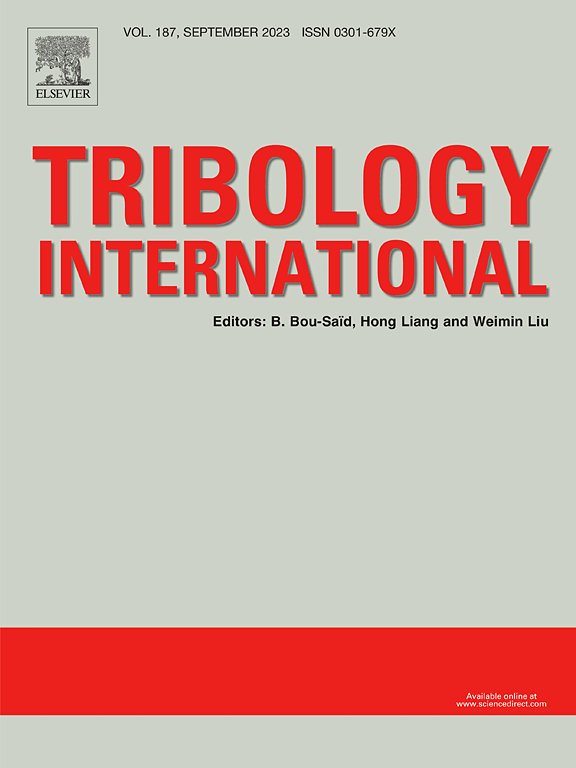Modelling of single grit micro-cutting of Ti-6Al-4V and In-718 with experimental validation
IF 6.1
1区 工程技术
Q1 ENGINEERING, MECHANICAL
引用次数: 0
Abstract
In the present study, a single-grit micro-cutting simulation model was developed for Ti-6Al-4V and In-718 work materials when ground with a single cBN grit on the grinding wheel hub. User-defined subroutines were implemented to integrate the phenomenon of dynamic recrystallization and strain gradient effect. Numerical simulations were performed using a pyramidal shaped and CT-scanned actual grit with varying grit orientations. The effect of process parameters and grit orientation on the mechanism of material removal, pile-up ratio, micro-cutting forces, specific micro-cutting energy, and chip morphology was analyzed for Ti-6Al-4V and In-718. The simulated results using CT-scanned grit agreed with experimental values. The average deviation of the pile-up ratio with varying micro-cutting velocity at maximum uncut chip thickness of 10 µm using CT-scanned grit for Ti-6Al-4V was 9.2 %, and for In-718 was 8.1 %. The comparison of the average effect of grit orientation on the peak magnitude of normal and tangential micro-cutting force obtained by numerical simulation at maximum uncut chip thickness of 10 µm and cutting velocity of 30 m/s using CT-scanned grit matched precisely with experimental values with an error of 3.2 % and 2.7 % for Ti-6Al-4V and 2.2 % and 3.8 % for In-718. The error of the simulated results for specific micro-cutting energy was 13.8 % for Ti-6Al-4V and 11.8 % for In-718. The developed modelling algorithm provides a valuable understanding for selecting effective grinding parameters for different alloys, provided the material constitutive parameters are given.
Ti-6Al-4V和In-718单粒度微切削建模及实验验证
在本研究中,建立了Ti-6Al-4V和In-718工作材料在砂轮轮毂上以cBN单粒磨削时的单粒微切削模拟模型。实现了用户自定义子程序,以整合动态再结晶现象和应变梯度效应。数值模拟使用锥体形状和ct扫描的实际砂粒进行,具有不同的砂粒方向。分析了工艺参数和磨粒取向对Ti-6Al-4V和In-718材料去除机理、堆积比、微切削力、比微切削能和切屑形貌的影响。ct扫描砂砾的模拟结果与实验值吻合。在最大未切割切屑厚度为10 µm时,不同微切削速度下,ct扫描粒度对Ti-6Al-4V的堆积比的平均偏差为9.2 %,对In-718的堆积比的平均偏差为8.1 %。在最大未切削切屑厚度为10 µm、切削速度为30 m/s时,通过ct扫描得到的砂粒取向对法向和切向微切削力峰值大小的平均影响与实验值吻合较好,Ti-6Al-4V的误差为3.2 %和2.7 %,In-718的误差为2.2 %和3.8 %。对于Ti-6Al-4V和In-718,模拟结果的比微切削能量误差分别为13.8 %和11.8 %。在给定材料本构参数的情况下,所开发的建模算法为选择不同合金的有效磨削参数提供了有价值的理解。
本文章由计算机程序翻译,如有差异,请以英文原文为准。
求助全文
约1分钟内获得全文
求助全文
来源期刊

Tribology International
工程技术-工程:机械
CiteScore
10.10
自引率
16.10%
发文量
627
审稿时长
35 days
期刊介绍:
Tribology is the science of rubbing surfaces and contributes to every facet of our everyday life, from live cell friction to engine lubrication and seismology. As such tribology is truly multidisciplinary and this extraordinary breadth of scientific interest is reflected in the scope of Tribology International.
Tribology International seeks to publish original research papers of the highest scientific quality to provide an archival resource for scientists from all backgrounds. Written contributions are invited reporting experimental and modelling studies both in established areas of tribology and emerging fields. Scientific topics include the physics or chemistry of tribo-surfaces, bio-tribology, surface engineering and materials, contact mechanics, nano-tribology, lubricants and hydrodynamic lubrication.
 求助内容:
求助内容: 应助结果提醒方式:
应助结果提醒方式:


